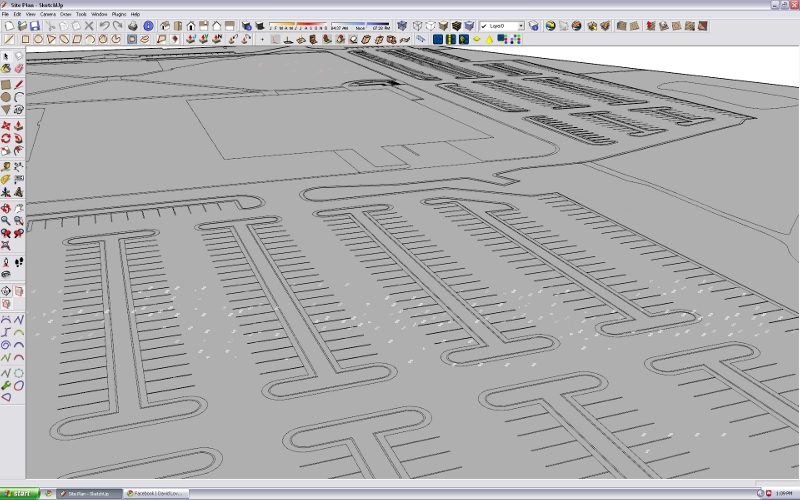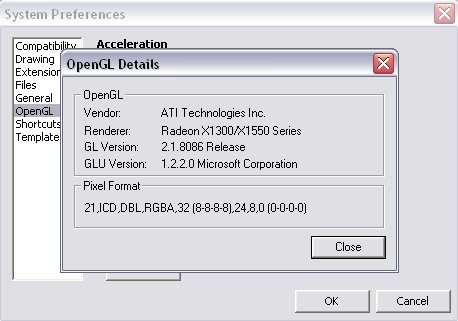Hardware recommendations
-
My workplace just bought a spanking new Dell computer with Q9550 CPU @ 4x2.83GHz and Nvidia 8800 GT Graphics card. Now I can wiz through all the models that I struggled on with my 8600M GT laptop. I recommend it to anyone. You do however need to update the graphic driver has the default one with Dell gave some diplay glitches when using SU.
-
I just upgraded my HD EAH 3870 video card to GTX 260 and here is my synopsis.
Comparing EAH3870, 9600GT and GTX260, I would Pick 9600GT. First of all unless ATI brings out more compatible driver for EAH 3870, it’s not worth it. (strictly speaking for SU purposes) SU bench mark for EAH3870 looks good as 9600GT but when you try to orbit or zoom, real-time motion is very jerky. GTX260 has best SU bench mark but BM doesn’t mean anything to me. Because real-time motion of model that is 30mg (which most of my model is) or over, box outline of the group starts to kick in and with this mode, speed is same for 9600GT and GTX260. With price tag that’s 1/2 as GTX260, I recommend 9600GT out of These three. -
I use Dual Core 2.0 GB, DDR II 2GB, Nvidia GE Force 256 but it still very slow to run a render Software such as Podium or VRay. Took about 20 minutes to render in 1024 x 786 pixel JPG. Could you help me to adjust my hardware, plz..??
-
depending on the complexity of the scene (and the amount of reflections/refractions/bump maps you use 20 minutes are fairly fast, as far as I know. (for comparison: for a proper render with an unbiased engine (Indigo for example) I leave my machine running for the whole night, something like 18 hours...)
-
sasrabirawa,
Jakob's right, if you think 20 mins is slow for a 1000px wide photo-real render then you're going to be disappointed for a couple of years yet.... at least until Intel start releasing multi-multi-core processors and software starts utilising them. I was used to leaving Vue overnight and Maxwell for a week or two (see my spec below) to get decent results until VRay blew them out of the water (in terms of speed).
-
I agree, 20 minutes for a render that size (assuming there was reflection and lights) is pretty fast actually.
-
First of all if I am posting in the wrong area I am truly sorry. I really appreciate all of the knowledge in this forum. Since I do not understand all of the information and terms I hope someone will answer if the following system will be good for sketchup and rendering (Kerkythea).
Dell Precision Workstation T5400, Windows Xp Pro 64bit, Quad Core INtel Xeon Processor E5540 (2.83GHz,2X6M l2,1333), 4GB DDR2 SDRAM FBD memory,667MHz, 512mb PCIe x16 NVidia Quadro FX 1700.
Any info would be greatly appreciated and again if this is in the wrong place please let me know where it should be. Thanks, Ron
-
rparsons,
Firstly welcome to GSCF.
Your rig as noted above is a great choice I do not see you having any problems with it.
-
As solo said, that rig sounds like it should be pretty solid. Get a good motherboard to go with it and you should have a good setup which should be good for some expansion, as well, if you ever feel the need.
-
Thanks Solo for your quick response. I feel more confident now about my decision. Any input from others would be also be appreciated.
Ron -
Dear all,
I have only been using SU for a couple of months now but I have upgraded to working on a desktop as aposed to my laptop which was struggling.
I went for a triple core processor with 4GB RAM and an NVidia GForce 9600. However it was still not giving me the result I had hoped for. When orbiting the model, many of the components were still being shown as a boundary box and the animation was jerky and sluggish.
So I upgraded the graphics card to an NVidia Quadro 1700. Surely this would do the trick.
Afraid not. What I thought was a hardware issue may well be human error. The model I am working on at the moment is 28.9MB. I feel the answer may lie with layers? Am I right? Any tips?
-
Thanks Remus and so I am not repeating myself I want to say thanks in advance to all who choose to respond to my earlier post. This forum is fantastic!
Ron
-
Sadz, the first thing to check is whether you have hardware acceleration on.
window->preferences->openGL and then turn on hardware acceleration and fast feedback.
If that doesnt work, how many faces are there in your model? this is the main thing that slows down a model in SU.
-
Has anyone had experience with SU on some of the GTX 200 class NVidia chips? like the GTX 260 and the GTC 280? I still haven't bought that desktop yet as I am waiting for the new i7Core to come out. Just read somewhere that the slowest one on release will be marginally slower that then QX9775 Extreme edition CPU
 , in benchmarks anyway. I can't wait.
, in benchmarks anyway. I can't wait. -
Does anyone have an idea what causes this? I updated my video driver so I could get the antialias feature to work but not I get these little white spots when I zoom in on the model and they flash when I rotate it... any help is greatly appreciated!


-
My company set me up with a Intel E6750 (2.66 GHz) dual-core, 2 GB RAM, 64-bit Vista, and a powerful 1GB video card (ATI FireGL V7350). However, after importing a site grading file, it was really sluggish. So I worked on my laptop (not nearly the powerhouse of my work pc) to get the file to where I wanted it, finishing up at 47MB. When trying to edit on my work desktop, orbiting posed no problems, but drawing was very sluggish and caused my pc to freeze on a number of occasions. I think that if my card would not try and render absolutely everything (must be cocky with it's 1GB capacity) and I could tune down the graphics specific to sketchup, I would have no problems. I've already configured Vista to minimize what the OS requires, though I don't see a way to configure my card's settings for specific applications. Any thoughts?
-
bub-
I have the same video card and recently updated the drivers like you. I ended up with all sorts of strange flickering and other effects when i used any of the style settings etc. I ended up rolling back the driver just so I could use SU. annoying
-
BubbaLove,
It is most probably a display driver issue. Things you can try:
- check that the card driver settings are set to the SU-recommended values (most important is Antialiasing, it should be set to "Application-controlled")
- turn off "Fast Feedback" in the SU OpenGL settings
- turn off "Use HArdware Acceleration" in the SU OpenGL settings to verify that your problem is display-driver related (this will slow down SU for all but the smallest models, so it is not a permanent solution)
- try to download and install a newer (or different) version of the display driver
- buy a Nvidia-based card instead
Anssi
-
Thanks guys, I was afraid that it might be the video card... just was hoping that it was something stupid I did. Anssi... this isn't the computer I usually do my modeling, I will be doing all my renders on this one but I just wanted to text if antialias worked cause this computer used to have Vista on and it didnt work at all! We put XP on it and Sketchup runs fine but just with those white spots... I can deal with it! Mirjman, I didn't realize this when I bout this damned computer from Dell... I've learned my lesson, I won't be jumping into a new OS like Vista anymore!
-
Its an ATI thing. I saw this happening in a number of occasions on a number of systems.
Either ATI isn't doing proper OpenGL implementation either the Sketchup Core (the rendering part) is not handling the OpenGL extensions in a nice way in order to achieve the "100%-same-output-on-all-graphics-cards" principle of usability and software quality.
Advertisement







